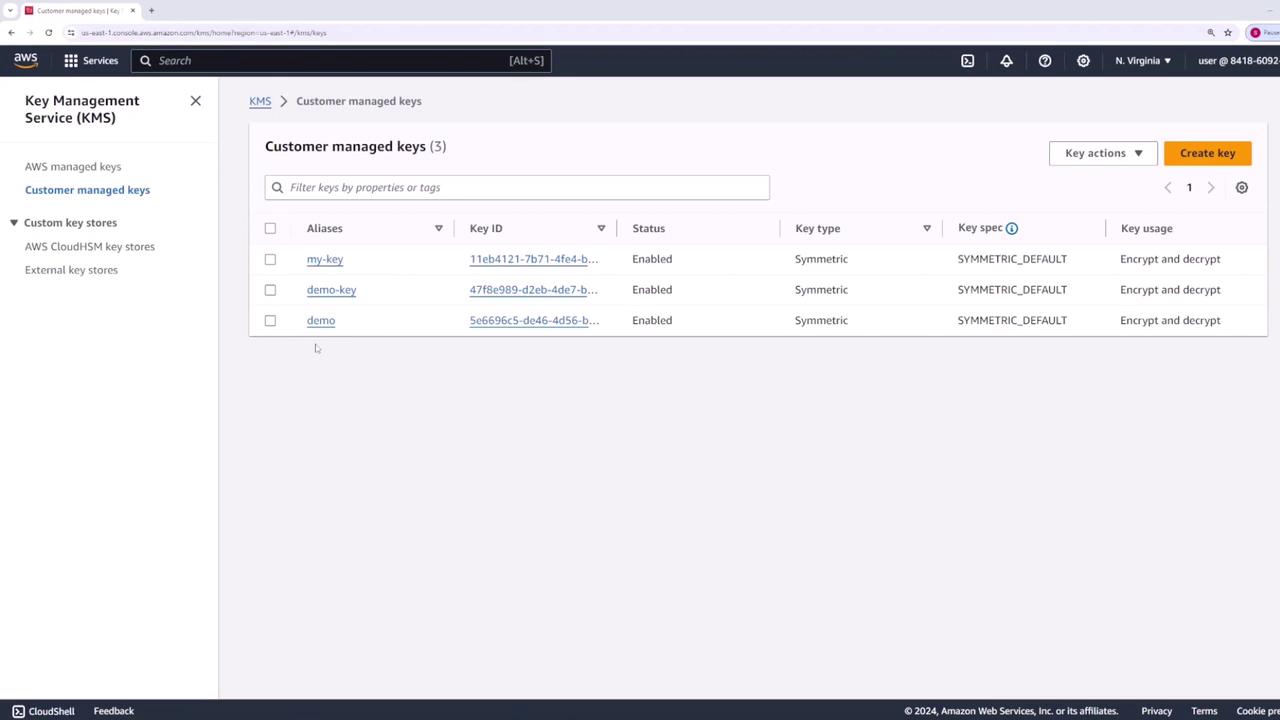AWS Certified Developer - Associate
Security
KMS Envelope Encryption Demo
In this lesson, you'll learn how to encrypt large files using AWS KMS envelope encryption. By leveraging envelope encryption, AWS KMS generates a data key from a primary KMS key that encrypts files of any size. Although we will use a sample file named "db-creds," the same steps apply to larger files.
Generating a Data Key
A KMS key (for example, one named "demo") can directly encrypt or decrypt data up to 4 KB. To handle larger files, we generate a data key through our KMS key. This data key is provided in two forms:
- The plaintext key, used by OpenSSL for file encryption.
- The encrypted key, stored securely for later decryption.
To generate a data key, run the following command:
aws kms generate-data-key --key-id alias/demo --key-spec AES_256
The command returns output similar to this:
{
"CiphertextBlob": "AQIDAHhPIn5jWlOkyhcTrOUNemva4jMiIW9RNFBBMjDPJwngHbFmSd7rWYRpzC32pUfq/AAAAfjfERTNoj8WtmQvDnN+ahOOU/1CB9U8odPg+UoEfgjdRiwahNNYgki76w==",
"Plaintext": "2gy7bq/apUh36hT39xYkEy+gHVA2yM2Y9RHM=",
"KeyId": "arn:aws:us-east-1:841869029733:key/5e6696c5-de46-4d56-bb50-a9b71e187cad"
}
The returned plaintext key is base64 encoded. Save it to a file after decoding. Similarly, decode and store the encrypted key. For instance:
echo '2gy7bp/qPhuH36NTR9xYKY+VHG+0VaM2Y9n/RHM=' | base64 -d > plaintext.key
echo 'AQIdAHIpIn5jWLoKhyTrOUNemva4jMiIwi9NRFBMjMDPJwNgBHF5dr7wRhp3zC32pFuHlxZxUz80Qo/fERTNoj8wtmQvDnN+a+oOUb/1C9bU8odPG+uOefgXlDrwsGiahNNYgki76w==' | base64 -d > encrypted-key
This diagram from the AWS KMS console displays your customer-managed keys, including the "demo" key:

Encrypting Data
With your plaintext data key ready, use it to encrypt the "db-creds" file with OpenSSL. Execute the following command:
openssl enc -e -aes256 -pass file:plaintext.key -in db-creds -pbkdf2 > encrypted-data
In this command:
- OpenSSL employs the AES-256 cipher.
- The encryption key is read from the provided plaintext key file.
- The
-pbkdf2flag ensures a secure key derivation and prevents warnings.
For enhanced security, remove the plaintext key file after encryption:
rm plaintext.key
Security Note
Removing the plaintext key from disk prevents it from being compromised, ensuring the security of your encrypted data.
Decrypting Data
To decrypt the encrypted data file later, follow these steps:
Decrypt the Encrypted Key Using AWS KMS
Run the command below to decrypt the stored encrypted key:
aws kms decrypt --ciphertext-blob fileb://encrypted-keyThe output will resemble:
{ "KeyId": "arn:aws:kms:us-east-1:841860927337:key/5e6696c5-de46-4d56-bb50-a9b71e187cad", "Plaintext": "2gyy7bp/qPhuH36N3T9xKY+VHG+0BVaM2Y9n/RHM=", "EncryptionAlgorithm": "SYMMETRIC_DEFAULT" }Store the Decrypted Plaintext Key
Decode the returned plaintext key and save it:
echo '2gyy7bp/qPhuH36N3T9xKY+VHG+0BVaM2Y9n/RHM=' | base64 -d > plaintext.keyDecrypt the Data Using OpenSSL
Now decrypt the file with this command:
openssl enc -d -aes256 -pass file:plaintext.key -in encrypted-data -out decrypted-data -pbkdf2The
-dflag indicates decryption. After executing this command, the file "decrypted-data" will match the original "db-creds" file.
Final Notes
Envelope encryption requires you to store both the encrypted data and the corresponding encrypted data key. When decryption is necessary, AWS KMS can be used to extract the plaintext key from the encrypted key. Then, OpenSSL uses this plaintext key to restore your original data. This method ensures the data key is never stored in plaintext for an extended period, enhancing your overall security.
Wrap-Up
By following this workflow, you effectively safeguard your sensitive data while leveraging the robust encryption capabilities offered by AWS KMS and OpenSSL.
That concludes our walkthrough on AWS KMS envelope encryption. Happy encrypting!
Additional Resources
Watch Video
Watch video content